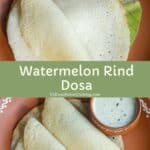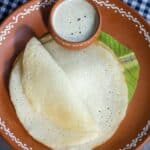Discover how to make soft and spongy dosa using watermelon rind! Yes, you can eat the rind of a watermelon. Explore this delightful watermelon rind dosa recipe, Kalingana Polo, with detailed step-by-step pictures and a video.
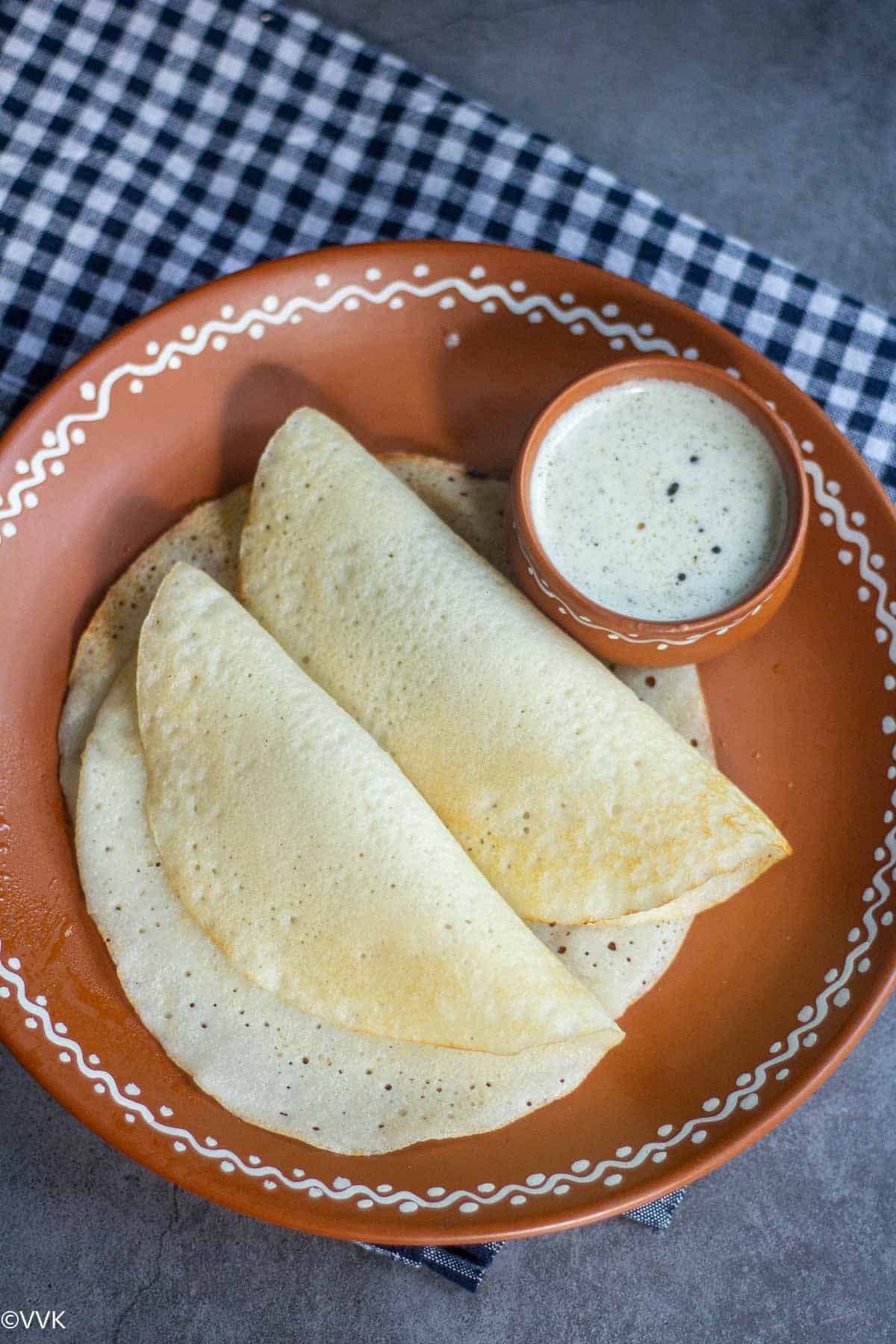
While I love enjoying juicy watermelon, I’m equally fond of its often-overlooked rind—the white fleshy part. Do you usually toss the watermelon rind? Please don’t! I have another fantastic recipe for you. I’ve already shared a Thai-style watermelon rind curry, and now it’s time for a South Indian classic—dosai. This watermelon rind dosa is especially popular in North Karnataka, and I’m excited to share my version with you.
Jump to:
How to prepare watermelon rind
Every time I slice a watermelon, I save the rind without peeling it, storing it in an airtight container. I peel off the green outer layer just before using it. You can also use the rind to make kootu or chutney. The texture of watermelon rind is similar to that of chayote squash (chow-chow), so you can use it in any recipe that calls for chayote squash. For more details, check out the video.
Ingredients required
- Rice: I typically use idli rice for all my idli and dosa recipes, including this one.
- Poha: I add thick poha and idli rice to achieve a soft and spongy dosa.
- Fenugreek Seeds: Although optional, I always include fenugreek seeds in my idli and dosa recipes out of habit.
- Watermelon Rind: You’ll need 1 cup of chopped rind, about 130 grams.
- Coconut: Use ¼ cup of grated coconut for added flavor. You can increase this to ½ cup, but no more than that.
In addition to these ingredients, you’ll need salt, water, and oil to make the dosa. For exact measurements, please refer to the recipe card.
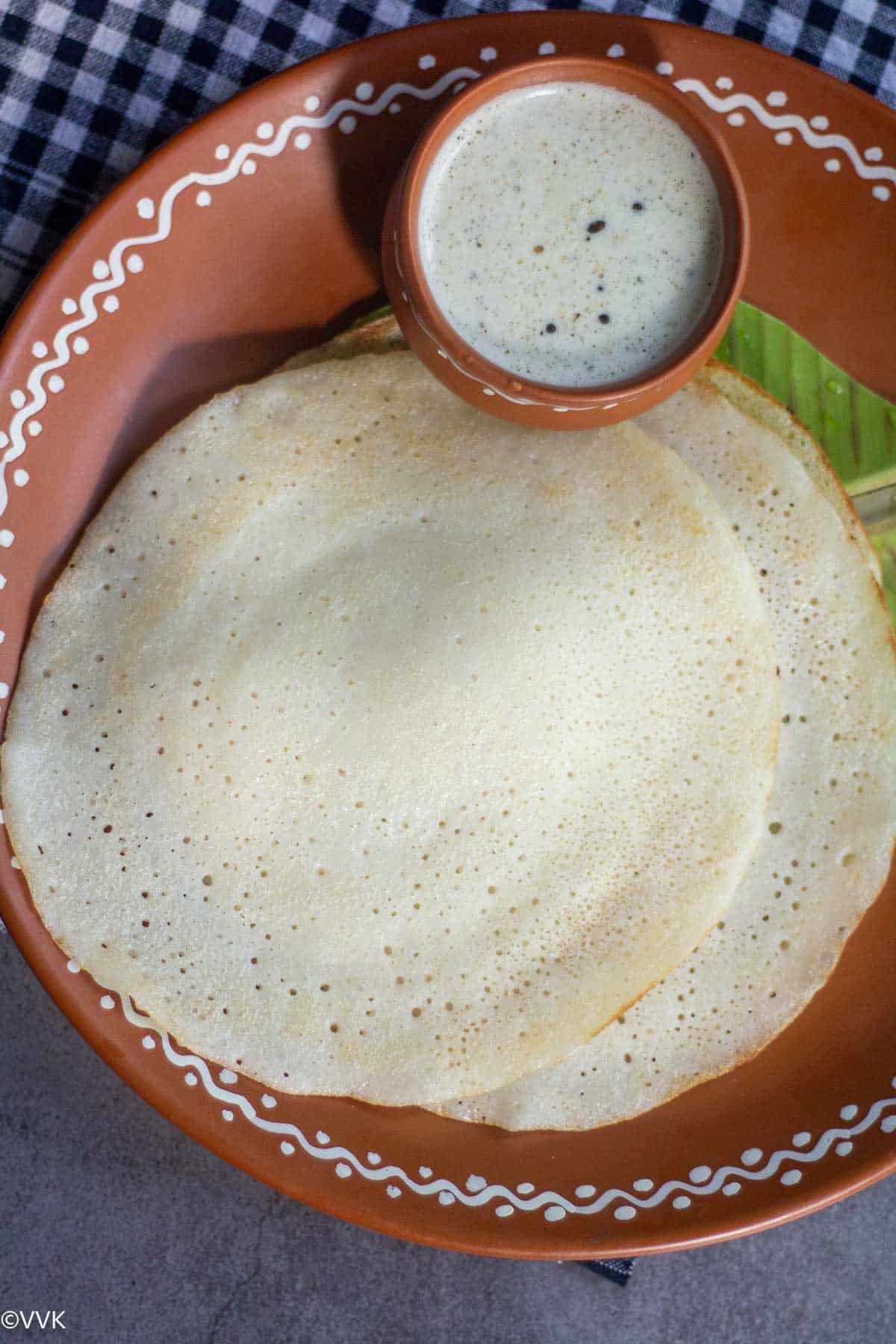
Dietary specifications and yield
This watermelon rind dosa is naturally vegan, nut-free, and gluten-free. The measurements provided yield about 10 to 12 dosas. We’ve always enjoyed them warm and haven’t stored them for more than 30 minutes.
How to make watermelon rind dosa
- Rinse the rice, poha, and fenugreek seeds, then soak them in enough water for 6 to 8 hours. I usually soak poha with the rice, but you can also soak it separately for 1 hour.
- Prepare 1 cup (approximately 130 grams) of chopped watermelon rind for this dosa. Add the rind and grated coconut to a mixer jar and grind them coarsely.
- Drain the water from the rice mixture, then add it to the mixer jar with 1.25 teaspoons of salt. Grind everything in batches to a smooth batter, using about ¾ cup of water. Transfer the batter to a bowl and mix well. Allow it to ferment for 6 to 8 hours.
- Once fermented, heat a tawa. When it’s hot, pour a ladleful of batter onto it, spreading it from the center outwards. Drizzle a little oil around the edges, cover, and cook for 50 to 60 seconds or until the top changes color. Gently loosen the edges with a flat spatula, flip the dosa, and cook for another 20 seconds. Your dosa is ready to enjoy!
- Serve this delicious watermelon rind dosa warm with your favorite side dishes, such as coconut chutney, onion chutney, sambar, or kurma.
Watch me make watermelon dosa
Recipe Notes
- I usually leave a bit of the red part of the watermelon on the rind, which adds a subtle sweetness to the dosa. If your watermelon is very sweet and you prefer a less sweet dosa, you should remove that part.
- Adjust the salt according to your taste.
- The water needed might vary depending on the watermelon rind and rice quality. Add water gradually to achieve the right batter consistency.
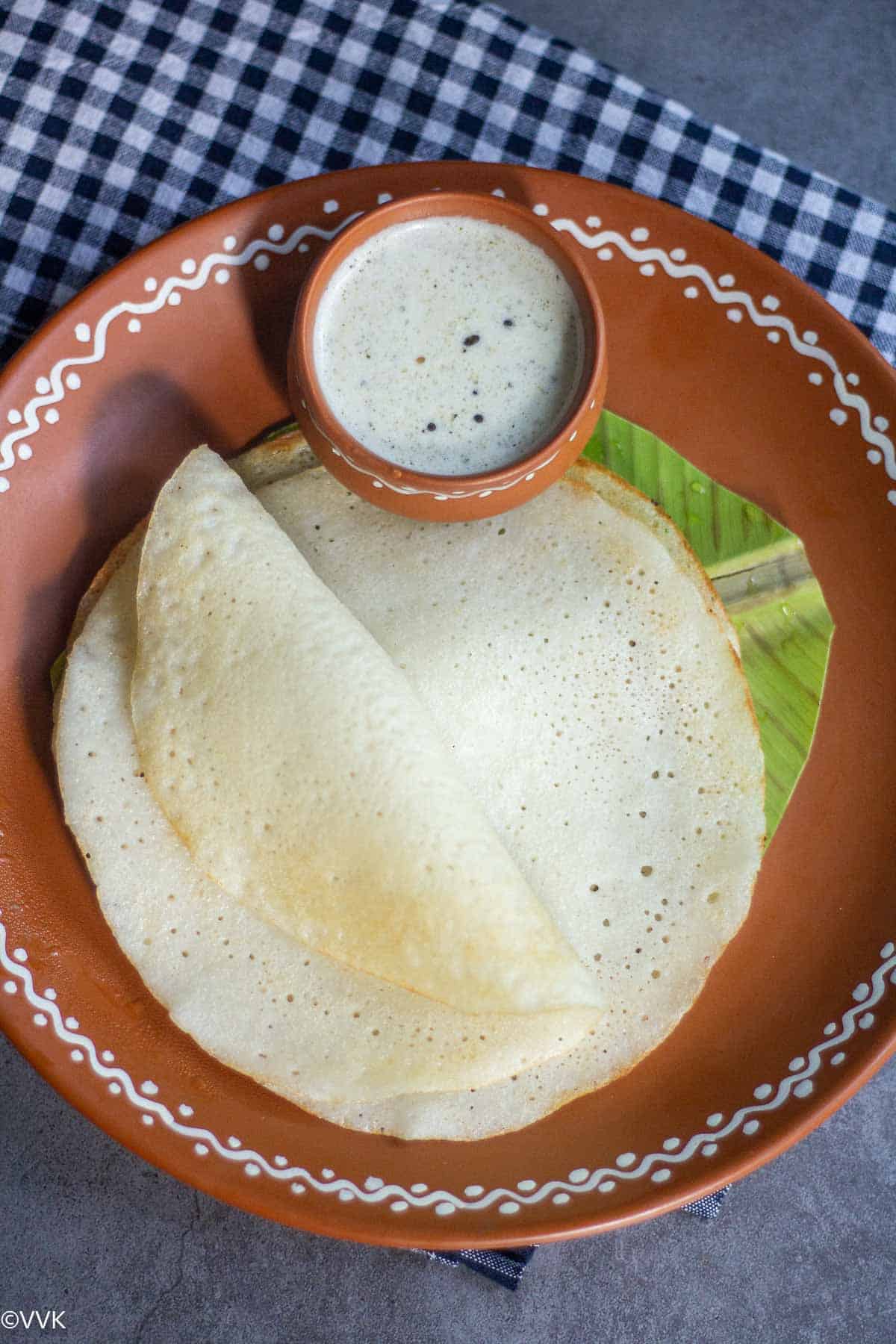
More dosa recipes
PS: If you try this watermelon rind dosa, please don’t forget to comment and rate this recipe. If you have any questions, please leave a comment, and I will get to it ASAP. Make sure to follow me on my Pinterest for more healthy and delicious ideas! Follow me on Instagram or join my Facebook Group for more recipe updates! You can also sign-up for my newsletter for weekly updates.
📖 Recipe
Watermelon Rind Dosa
Learn how to transform watermelon rind into a delicious and unique dish with our watermelon rind dosa recipe. Try this South Indian classic and savor the soft and spongy dosa.
Servings: 4 yields 12 dosas
Calories: 303kcal
Ingredients
Measurement Details: 1 cup=240ml; 1 tbsp = 15ml; 1 tsp = 5ml;
Instructions
-
Rinse the rice, poha, and fenugreek seeds, then soak them in enough water for 6 to 8 hours. I usually soak poha with the rice, but you can also soak it separately for 1 hour.
-
Prepare 1 cup (approximately 130 grams) of chopped watermelon rind for this dosa. Add the rind and grated coconut to a mixer jar and grind them coarsely.
-
Drain the water from the rice mixture, then add it to the mixer jar with 1.25 teaspoons of salt. Grind everything in batches to a smooth batter, using about ¾ cup of water. Transfer the batter to a bowl and mix well. Allow it to ferment for 6 to 8 hours.
-
Once fermented, heat a tawa. When it’s hot, pour a ladleful of batter onto it, spreading it from the center outwards. Drizzle a little oil around the edges, cover, and cook for 50 to 60 seconds or until the top changes color. Gently loosen the edges with a flat spatula, flip the dosa, and cook for another 20 seconds. Your dosa is ready to enjoy!
-
Serve this delicious watermelon rind dosa warm with your favorite side dishes, such as coconut chutney, onion chutney, sambar, or kurma.
Video
Notes
- I usually leave a bit of the red part of the watermelon on the rind, which adds a subtle sweetness to the dosa. If your watermelon is very sweet and you prefer a less sweet dosa, you should remove that part.
- Adjust the salt according to your taste.
- The water needed might vary depending on the watermelon rind and rice quality. Add water gradually to achieve the right batter consistency.
Nutrition
Calories: 303kcal | Carbohydrates: 50g | Protein: 5g | Fat: 9g | Saturated Fat: 2g | Polyunsaturated Fat: 2g | Monounsaturated Fat: 5g | Trans Fat: 0.03g | Sodium: 733mg | Potassium: 129mg | Fiber: 1g | Sugar: 3g | Vitamin A: 216IU | Vitamin C: 3mg | Calcium: 22mg | Iron: 1mg
I am not a nutritionist. The nutritional information is provided as a courtesy and is an estimate only. It varies depending upon the product types or brands.

